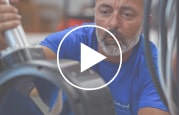Technical support
Frequently asked questions to our technical support
Do you have any questions about hybrid electric marine propulsion technology? You’ve come to the right place! Our Frequently Asked Questions offer comprehensive answers to guide you through the innovative world of hybrid electric boat motors.
Can’t find the answer to your question?
1. Reduced pollutant emissions: Compared to combustion engines, BlueNav engines do not emit greenhouse gases and air pollutants. This contributes to better air quality and environmental protection. This contributes to better air quality and environmental protection.
2. Reduced noise: BlueNav engines are silent. This improves passenger comfort and minimizes disturbance to marine life.
3. Optimized maintenance: By promoting the use of an electric propulsion system, you increase the maintenance intervals of the thermal propulsion system.
4. Regulatory benefits: More and more sites are prohibited from accessing thermal engines. The BlueSpin solution allows you to navigate in protected areas using clean energy.
5. Increased maneuverability: our two turbines align at angles of 45° and -45°, allowing you to rotate 360°. You can still move forward or backward using the propulsion levers. This maneuverability is particularly useful for entering and leaving your boat in port.
6. Navigation comfort: thanks to our software features (autopilot, virtual anchor, docking modes), navigate effortlessly and precisely.
Other electric hybrid systems for boats require compromises related to the joint presence of two engines, one thermal and the other electric, turning the same propeller. This propeller is necessarily unsuitable for one of the two systems, generally the less powerful. The installation of these systems also requires a significant modification of the propulsion system.
The BlueNav hybridization solution allows you to add an electric propulsion system with a retractable turbine, called BlueSpin, to the boat. The BlueSpin system is installed without modifying the original inboard or outboard propulsion. The modification costs are therefore lower: the BlueSpin system integrates into your boat without compromise.
To switch to electric propulsion, simply deactivate your thermal propulsion, then activate your BlueSpin system in a few clicks on our control panel. You are then ready to navigate!
There is no typical boat. The BlueNav solution can be adapted to many types of boats depending on the integration of the engines and the energy storage system. Our sales and technical teams will be able to guide your installer in taking these parameters into account.
However, we can mention open boats, cockpit boats, classic or modern, inflatables or semi-rigid boats, houseboats, surveillance vessels, fishing boats as well as monohull or multihull sailboats.
Regarding the 15kW version of our engines, we can equip boats ranging from 9 to 15m (30-66ft) for weights of up to 15 tons.
We will also soon be able to equip boats ranging from 7 to 10m (21-33ft) for weights of up to 8 tons, thanks to an 8kW version of our engines.
The autonomy depends on the energy storage capacity of the battery (expressed in kWh) and the energy consumption of the motorization (expressed in kW). The two important factors are therefore the type of battery used (not supplied by BlueNav) and the use made of the BlueSpin motorization.
The BlueSpin system is designed for quiet navigation. BlueNav recommends that its installers plan for a half-power autonomy of 2 to 4 hours.
Regularly clean electric motors to remove dirt, salt, shells, algae and other debris that may accumulate. Use fresh water and a clean cloth to clean exterior surfaces.
Check electrical connections for proper condition: they should be clean and properly tightened. Loose or corroded connections can cause loss of performance or failure.
Use electric motors according to the recommendations in the documentation. Avoid overloading and overheating by operating motors within their rated capacity.
Have your electric motors checked regularly by a qualified professional to detect any potential problems. Regular preventive maintenance can help identify and resolve problems before they become serious.
Follow the manufacturer’s recommendations for charging, discharging and maintaining batteries to extend their life.
BlueNav is not a battery manufacturer, but your integrator will be able to recommend products suited to your use.
The electric propulsion speed of your boat does not only depend on the BlueNav motor.
It also depends on the shape of the hull, the weight and size of the boat, as well as external elements (wind, currents, waves).
If you have any doubts or questions about the speed of your boat in electric mode, do not hesitate to contact us, we can assist you in your calculations.
we can assist you in your calculations.
BlueNav is not the supplier of the batteries to which the BlueSpin system(s) are connected. Refer to the specifications of the batteries used on board.
Depending on the configuration and the number of engines installed, it is possible to control the thrust up to 360°. This offers a great advantage to all equipped boaters: you can turn the boat on the spot.
With the BlueSpin system, you can also move along the transverse axis of your boat (Lateral Docking). This allows you to facilitate docking maneuvers to get closer to a dock.
Depending on the configuration, the number of engines installed and your NMEA 2000 equipment on board, it is possible thanks to our software features:
– To park with an accuracy of ±5m at bow level thanks to the Virtual Anchor feature;
– To maintain a heading thanks to the Heading Hold feature;
– To follow a route thanks to the Course Hold feature;
– To follow points placed on your mapping application thanks to the Waypoint Tracking feature.
Yes, the only sound perceptible is that of the flow of water in contact with the hull.
An electric propulsion does not emit any fumes or odors.
This is not necessary, our application is accessible on most recent MFD screens from the main manufacturers (Raymarine, Simrad, B&G, Lowrance, Garmin, Furuno).
It all depends on the generation of MFD (performance/latency of the screen). The list of compatible screens is available in our technical documentation and can be sent to you on request.
You have access to:
– Real-time data specific to the BlueSpin system such as engine speed (RPM) and power (kW), thrust orientation, turbine position, etc.
– Data available on your boat’s NMEA 2000 network such as speed, state of charge and remaining battery life, etc. This data depends on the sensors and probes installed on board.
The steering joystick on the BlueSpin system control panel allows you to steer your boat precisely.
No. The BlueSpin system comes with its own steering controls.
No, the BlueSpin system is physically steered. A captain must ensure navigation on board.
Sizing an electric propulsion system for a boat depends on a number of factors. Here are a few criteria to consider:
Type of boat: the size, weight and shape of the boat influence the choice of electric propulsion system.
Boat use: determine whether the boat will be used for short or long trips, the desired speed, the type of course (calm or rough waters), etc.
Autonomy: battery capacity and required autonomy determine the size and type of batteries to be installed.
Propulsion power: calculate the power required according to the desired speed, boat weight and sailing conditions.
Water resistance: propulsion efficiency is influenced by water resistance. Hull and propeller design must be optimized to reduce drag.
Integrating an electric propulsion solution on a boat can vary in complexity depending on a number of factors, including the size and type of boat, the existing electrical system, power requirements, and the specific characteristics of the electric propulsion chosen. In some cases, integration may be relatively simple and straightforward, while in others more extensive modifications may be required.
This depends on your navigation area or country. The safety regulations and standards of your navigation area apply to the BlueSpin system as long as they are not restricted to the use of a thermal engine.
Also find out about the legal frameworks specifically concerning the installation of electric propulsion on a boat.
To our knowledge, there is no specific permit differentiating the use of an electric or hybrid boat with that of a thermal boat.
BlueNav systems operate at very low voltage 48V DC. This limits the risks but does not eliminate them.
Make sure that electrical components are protected from water splashes. Never work on an electrical system that is live and without the appropriate skills.
Compatibility with the existing system: it is important to check that the electric propulsion system is compatible with the boat’s existing electrical components and systems. This may require modifications to ensure that all elements work harmoniously together.
Physical installation: the installation of electric motors, batteries and other propulsion components may require adjustments to the boat’s structure and interior layout. This may include creating storage spaces for batteries and motor power units, installing brackets for electric motors, fitting aerators and routing electrical cables.
The successful integration of hybrid electric propulsion requires technical expertise, an understanding of the specific needs of the boat and its operation, appropriate planning, and knowledge of local regulations.
Browse our
commercial documentation
Discover our complete solution below.

Check out our video tutorials !
Our Youtube channel



